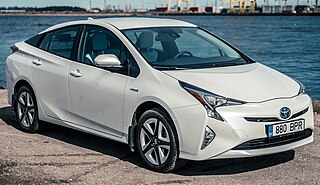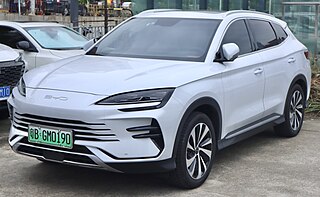
The Toyota Prius is a compact/small family liftback produced by Toyota. The Prius has a hybrid drivetrain, combined with an internal combustion engine and an electric motor. Initially offered as a four-door sedan, it has been produced only as a five-door liftback since 2003.

The Honda Insight is a hybrid electric vehicle that is manufactured and marketed by Honda. Its first generation was a two-door, two passenger liftback (1999–2006) and in its second generation was a four-door, five passenger liftback (2009–2014). In its third generation, it became a four-door sedan (2018–2022). It was Honda's first model with Integrated Motor Assist system and the most fuel efficient gasoline-powered car available in the U.S. without plug-in capability — for the length of its production run.

The Ford Escape is a compact crossover SUV manufactured and marketed by Ford Motor Company since the 2001 model year. The first Ford SUV derived from a car platform, the Escape fell below the Ford Explorer in size; the Escape is currently sized between the Ford EcoSport and Ford Edge. The 2004 Ford Escape Hybrid was the first hybrid-electric vehicle from Ford, and the first hybrid produced as an SUV.

The Toyota RAV4 EV is an all-electric version of the popular RAV4 SUV produced by Toyota until 2014. Two generations of the EV model were sold in California, and to fleets elsewhere in the US, with a gap of almost ten years between them.

The Ford Fusion Hybrid is a gasoline-electric hybrid powered version of the mid-sized Ford Fusion sedan manufactured and marketed by Ford, now in its second generation. A plug-in hybrid version, the Ford Fusion Energi, was released in the U.S. in February 2013.

The Ford C-Max is a car produced by the Ford Motor Company from 2003 to 2019. It has a five-door compact multi-purpose vehicle (MPV) design. The Ford Grand C-Max has a longer wheelbase.
Hybrid Synergy Drive (HSD), also known as Toyota Hybrid System II, is the brand name of Toyota Motor Corporation for the hybrid car drive train technology used in vehicles with the Toyota and Lexus marques. First introduced on the Prius, the technology is an option on several other Toyota and Lexus vehicles and has been adapted for the electric drive system of the hydrogen-powered Mirai, and for a plug-in hybrid version of the Prius. Previously, Toyota also licensed its HSD technology to Nissan for use in its Nissan Altima Hybrid. Its parts supplier Aisin offers similar hybrid transmissions to other car companies.

A plug-in hybrid electric vehicle (PHEV) is a type of hybrid electric vehicle equipped with a rechargeable battery pack that can be replenished by connecting a charging cable into an external electric power source, in addition to internally by its on-board internal combustion engine-powered generator. While PHEVs are predominantly passenger cars, there are also plug-in hybrid variants of sports cars, commercial vehicles, vans, utility trucks, buses, trains, motorcycles, mopeds, military vehicles and boats.

The Ford Fusion is a mid-size car that was manufactured and marketed by the Ford Motor Company. From the 2006 through 2020 model years, two generations of the Fusion have been produced in gasoline, gas/electric hybrid, and gas/plug-in electric hybrid variants. The Fusion was manufactured at Ford's Hermosillo Stamping and Assembly plant in Sonora, Mexico, alongside the Lincoln MKZ, and formerly the Mercury Milan, both of which share its CD3 platform.
Hybrid vehicle drivetrains transmit power to the driving wheels for hybrid vehicles. A hybrid vehicle has multiple forms of motive power.

A hybrid electric vehicle (HEV) is a type of hybrid vehicle that combines a conventional internal combustion engine (ICE) system with an electric propulsion system. The presence of the electric powertrain is intended to achieve either better fuel economy than a conventional vehicle or better performance. There is a variety of HEV types and the degree to which each functions as an electric vehicle (EV) also varies. The most common form of HEV is the hybrid electric car, although hybrid electric trucks, buses, boats, and aircraft also exist.

The history of plug-in hybrid electric vehicles (PHEVs) spans a little more than a century, but most of the significant commercial developments have taken place after 2002. The revival of interest in this automotive technology together with all-electric cars is due to advances in battery and power management technologies, and concerns about increasingly volatile oil prices and supply disruption, and also the need to reduce greenhouse gas emissions. Between 2003 and 2010 most PHEVs on the roads were conversions of production hybrid electric vehicles, and the most prominent PHEVs were aftermarket conversions of 2004 or later Toyota Prius, which have had plug-in charging and more lead-acid batteries added and their electric-only range extended.

The seventh-generation Honda Civic is an automobile produced by Honda from 2000 until 2005. It debuted in September 2000 as a 2001 model. Its exterior dimensions stayed similar to the outgoing predecessor, with interior space significantly increased, bumping it up to the compact car size designation. A notable feature was the flat rear floor that gave better comfort to the rear seat passengers. This generation abandoned the front double wishbone suspension, used previously from fourth to sixth generations, replacing it with MacPherson struts. This generation was the last to offer 4WD variants.

The Lexus HS is a dedicated hybrid vehicle introduced by Lexus as a new compact executive car sedan in 2009. Built on the Toyota New MC platform, it is classified as a compact under Japanese regulations concerning vehicle exterior dimensions and engine displacement. Unveiled at the North American International Auto Show in January 2009, the HS 250h went on sale in July 2009 in Japan, followed by the United States in August 2009 as a 2010 model. The HS 250h represented the first dedicated hybrid vehicle in the Lexus lineup, as well as the first offered with an inline-four gasoline engine. Bioplastic materials are used for the vehicle interior. With a total length of 4,700 mm (190 in), the Lexus HS is slightly larger than the Lexus IS, but still smaller than the mid-size Lexus ES.

The adoption of plug-in electric vehicles in the United States is supported by the American federal government, and several states and local governments.

The Toyota Prius Plug-in Hybrid is a plug-in hybrid liftback manufactured by Toyota. The first-generation model was produced from 2012 to 2016. The second-generation model has been produced since 2016. Production of the third-generation model began in 2023.

The Toyota Prius is a full series-parallel hybrid electric compact car developed and manufactured by the Toyota Motor Corporation. The second generation Prius had been completely redesigned with a kammback profile. The XW20 series represented the second generation of the Toyota Prius, replacing its XW10 predecessor. The United States Environmental Protection Agency (EPA) and California Air Resources Board (CARB) rated the Prius as among the cleanest vehicles sold in the United States based on smog forming and toxic emissions in 2008. Toyota sold about 1,192,000 units of the second generation Prius worldwide.

The Toyota Prius (XW10) is a subcompact hybrid car that was produced by Toyota between 1997 and 2003 in Japan. The XW10 is divided into the NHW10 and its NHW11 counterpart, both of which represent the first generation of Prius series. The Toyota Prius is the first mass-produced hybrid car, and was released 2 years ahead of other manufacturers. While the NHW10 was available exclusively to Japan, it was subsequently introduced to worldwide markets in September 2000 with the NHW11. Toyota sold about 123,000 first generation Prius. Toyota's XW10 series Prius is notable as the first vehicle based on the Toyota MC platform.

The Toyota Priusv, also named Prius α in Japan, and Prius+ in Europe and Singapore, is a hybrid gasoline-electric automobile produced by Toyota introduced in Japan in May 2011, in the U.S. in October 2011, and released in Europe in June 2012. The Prius v was unveiled at the January 2011 North American International Auto Show alongside the Prius c Concept, and it is the first Prius variant to be spun off from the Prius platform. According to Toyota the "v" stands for "versatility". It is a compact MPV with a standard full hybrid drivetrain.

The Toyota Prius c (c stands for "city"), also known as the Toyota Aqua (Japanese: トヨタ・アクア, Hepburn: Toyota Akua); "aqua" is Latin for water) in Japan, is a full hybrid gasoline-electric subcompact/supermini hatchback manufactured and marketed by Toyota. The Prius c is the third member of the Prius family, and combines the features of a Yaris-sized car with a hybrid powertrain. The Prius c is priced lower than the conventional Prius and has a higher fuel economy in city driving under United States Environmental Protection Agency test cycles. The Prius c was ranked by the EPA as the 2012 most fuel efficient compact car when plug-in electric vehicles are excluded.
























